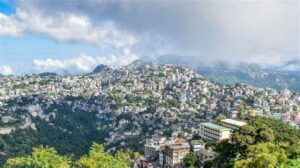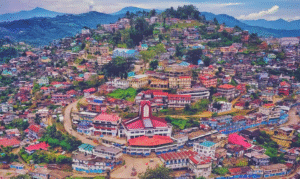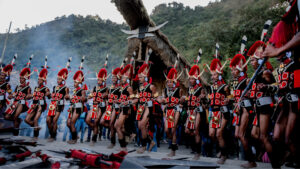High in the Eastern Himalayas lies one of the most sacred, serene, and architecturally magnificent spiritual centers of Tibetan Buddhism – Rumtek Monastery. Often referred to as the Dharma Chakra Centre, this revered gompa is not only the largest monastery in Sikkim but also one of the most significant religious and cultural hubs for the Kagyu sect of Tibetan Buddhism.
This blog explores the history, spiritual significance, architecture, rituals, and cultural essence of Rumtek Monastery while also highlighting its contemporary relevance in Buddhist education and pilgrimage tourism.
Historical Background of Rumtek Monastery
Origin and Early Foundation
Rumtek Monastery traces its origins back to the 16th century when it was first established by the 9th Karmapa, Wangchuk Dorje, the head of the Karma Kagyu lineage. At that time, it served as a small monastic retreat and spiritual center for followers of the Kagyu tradition in the region.
Over the centuries, the original structure suffered from neglect and deterioration. However, the real transformation of Rumtek Monastery began in the 20th century.
Rebirth under the 16th Karmapa
In the 1950s, following the Chinese invasion of Tibet, the 16th Gyalwa Karmapa, Rangjung Rigpe Dorje, fled from Tsurphu Monastery in Tibet to Sikkim. With the support of the then King of Sikkim, he decided to rebuild Rumtek as the new seat of the Karma Kagyu lineage outside Tibet.
Construction began in 1960 and was completed in 1966. This monumental reconstruction made Rumtek Monastery not only a place of spiritual refuge but also a symbol of resilience and continuity for Tibetan Buddhism in exile.
Architectural Grandeur
Traditional Tibetan Aesthetics
Rumtek Monastery exemplifies traditional Tibetan architecture with intricate murals, golden spires, fluttering prayer flags, and ornate woodwork. The monastery is built in accordance with Vajrayana Buddhist architecture, symbolizing a mandala – a representation of the universe.
Three-Tiered Complex
Rumtek is a three-tiered complex, with each level serving a different spiritual and functional purpose:
- Lower Level – Residential quarters for monks and administrative offices.
- Middle Level – The main prayer hall adorned with thangkas, statues, and a giant image of Buddha.
- Upper Level – The Golden Stupa, containing the relics of the 16th Karmapa.
Dharma Chakra Centre
Adjacent to the main monastery is the Dharma Chakra Centre, established as a center for Buddhist learning. It houses a library with a vast collection of ancient Buddhist scriptures and texts, a retreat center, and a monastic college (Shedra).
Spiritual and Religious Importance
Seat of the Karmapa
Rumtek is the seat-in-exile of the Karmapa, the spiritual head of the Karma Kagyu school – one of the four major schools of Tibetan Buddhism. The Karmapa holds a position similar to that of the Dalai Lama in the Gelugpa school.
As such, Rumtek plays a central role in preserving the Karma Kagyu teachings, conducting religious rituals, and training monks in traditional Buddhist philosophy and meditation.
Sacred Relics and Artifacts
One of the monastery’s most revered possessions is the Black Hat (Vajra Mukut), believed to have been given to the first Karmapa by the dakinis. It is kept under tight security and is shown only on special occasions due to its spiritual potency.
The monastery also houses precious relics, thangkas, statues, and ritual instruments used in daily and ceremonial practices.
Festivals and Rituals at Rumtek
Losar – Tibetan New Year
Losar is the most significant festival celebrated at Rumtek Monastery. Marking the Tibetan New Year, this festival sees vibrant mask dances, offerings, chanting of sacred texts, and public blessings.
Mahakala Puja
The Mahakala Puja is another major event, performed before the New Year to dispel negativity and invoke protection. Monks dress in elaborate costumes, perform ritual dances, and chant powerful mantras.
Kagyu Monlam Chenmo
Rumtek is one of the few monasteries in India that organizes the Kagyu Monlam Chenmo, a great prayer festival initiated by the Karmapa. It draws thousands of monks and lay followers from around the world who gather for world peace and enlightenment.
Role in Buddhist Education
Karma Shri Nalanda Institute
Rumtek is home to the Karma Shri Nalanda Institute for Higher Buddhist Studies, which offers advanced training in Buddhist philosophy, logic, ethics, and metaphysics. The institute follows a rigorous curriculum based on ancient texts and traditions.
Students undergo years of training before becoming fully ordained monks, teachers, or spiritual leaders. Many who study here go on to teach across Buddhist centers globally.
Geographical Location and Accessibility
Where is Rumtek Located?
Rumtek Monastery is located in Rumtek village, approximately 23 kilometers from Gangtok, the capital of Sikkim. It sits at an altitude of 5,800 feet, surrounded by lush greenery, dense forests, and panoramic views of the Eastern Himalayas.
How to Reach
- By Road: Rumtek is accessible by shared taxis or private vehicles from Gangtok.
- Nearest Airport: Pakyong Airport, about 30 km away.
- Nearest Railway Station: New Jalpaiguri (NJP), around 120 km away.
Though the road to Rumtek is winding, the scenic beauty along the way makes the journey a visual treat.
Contemporary Challenges and Controversies
Karmapa Controversy
Rumtek Monastery has been at the center of the Karmapa controversy, a complex dispute over the legitimate successor to the 16th Karmapa. Two candidates – Ogyen Trinley Dorje and Trinley Thaye Dorje – have been recognized by different factions, causing a rift within the Karma Kagyu lineage.
Due to this, the monastery has experienced administrative deadlocks, legal battles, and security interventions. Entry to some parts of the monastery remains restricted for this reason.
Preservation and Tourism Impact
As one of the most visited spiritual destinations in Northeast India, Rumtek faces challenges related to sustainable tourism, infrastructure pressure, and cultural dilution. Efforts are ongoing to balance the preservation of spiritual sanctity with tourism development.
Rumtek as a Pilgrimage and Tourist Attraction
Why Visit Rumtek?
For spiritual seekers, Buddhists, and cultural enthusiasts, Rumtek offers:
- A chance to witness living Tibetan Buddhist traditions.
- Participation in sacred rituals and festivals.
- Exploration of monastic art, sculpture, and architecture.
- Immersion in a tranquil and meditative environment.
Tips for Visitors
- Dress modestly and behave respectfully inside the monastery premises.
- Photography is restricted in certain areas.
- Visit during festivals for a deeper cultural experience.
- Hire local guides to learn about the intricate symbolism and monastic life.
Rumtek Monastery in Popular Culture and Literature
Rumtek Monastery has been featured in documentaries, travelogues, and scholarly works on Buddhism. Its significance as a spiritual refuge post the Chinese occupation of Tibet makes it a poignant symbol of resilience.
The monastery also finds mention in books and films exploring the spiritual geography of the Himalayas and the evolving dynamics of Tibetan Buddhism in exile.
Conclusion
Rumtek Monastery is not just the largest monastery in Sikkim—it is a living legacy of Tibetan Buddhism, a sanctuary for spiritual learning, and a cultural beacon in the Eastern Himalayas. Its peaceful ambience, sacred rituals, monastic discipline, and architectural splendor make it a must-visit for anyone seeking to connect with the deeper essence of Himalayan spirituality.
Despite modern challenges, Rumtek continues to thrive as a symbol of faith, resilience, and the unbroken lineage of the Karmapas. Whether you’re a pilgrim, a student of religion, or a curious traveler, Rumtek promises an experience that transcends time, space, and worldly concerns.






